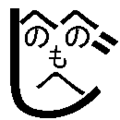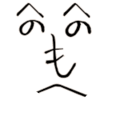Henohenomoheji

Henohenomoheji (へのへのもへじ) or hehenonomoheji (へへののもへじ) is a face drawn by Japanese schoolchildren using hiragana characters.[1]
The word breaks down into the seven hiragana characters: he (へ), no (の), he (へ), no (の), mo (も), he (へ), and ji (じ). The first two he are the eyebrows, the two no are the eyes, the mo is a nose, and the last he is the mouth. The outline of the face is made by the character ji, its two short strokes (dakuten) forming the ear or cheek. Children use the henohenomoheji as the faces of kakashi (scarecrows)[1] and Teru teru bōzu.
Variations

Other versions may have been current in other epochs and places. Japanese-Brazilians who learned hiragana in the 1950s, in the State of São Paulo, report that they were not taught to draw the ji, and thus left the face unframed, as in the henohenomohe shown at right.
Other people from the same epoch but from other towns in São Paulo report that they learned to draw a big no around the face, instead of the ji (not shown).
Others have drawn the henohenomoheji with an extra i (い) at the end, which is drawn under the ji to form a neck or an ear.
In popular culture
TV drama
- In the opening sequence of the 1967 TV drama Comet San, the main character (played by Yumiko Kokonoe) uses her magic to draw a henohenomohe on the surface of the moon.[2]
Anime
- In the Naruto anime, the face of the character Kakashi Hatake, whose given name Kakashi means "scarecrow", is the subject of an entire episode (no. 101) in which his students try to remove his mask. Against one of them he uses a scarecrow as a decoy, with the henohenomoheji drawn on the face. Later he summons eight dogs which have the henohenomoheji on their backs.
Also in the spin-off anime Rock Lee No Seishun Powerfull Ninden, the narrator's face is a henohenomoheji.
- In the One Piece anime, Igaram makes dummies with the henohenomoheji face to impersonate Luffy, Zoro, and Nami.
- In the anime Mononoke, the Medicine Seller briefly wears a henohenomoheji on his blank face during the Noppera-bō arc before restoring his own.
- In the anime Samurai Champloo, the baseball catcher doll in episode 23 ("Baseball Blues") has a henohenomoheji on its face. At the beginning of episode 11 ("Gamblers and Gallantry), henohenomoheji appears as the face of a doll hanging before Fuu.
- Henohenomoheji has been drawn twice by schoolchildren on Ojamajo Doremi. On the 15th episode of Ojamajo Doremi #, Masaru Yada painted a large henohenomoheji on a piece of paper with red paint when he was meant to paint a portrait of his mother. On the 15th episode of Motto Ojamajo Doremi, Hesebe drew a henohenomoheji on a piece of paper with red crayon when he was meant to draw a portrait of his mother.
- In The Melancholy of Haruhi Suzumiya anime, a brief scene in episode 11 ("The Day of Sagittarius") showed Koizumi's fleet with a crew full of henohenomoheji.
- In episode 3 of the Hyakko anime, a slightly different henohenomoheji can be seen drawn on a cardboard box: it has no ji, a shi for its nose and another shi for its ear, which reads out henohenoshiheshi. Later on in the same episode, a more classical version can be seen painted on a robot's face, with only the eyes and the nose (henohenomo) and a speaker for its mouth.
- In chapter 25 of the Demashita! Powerpuff Girls Z, the monster Penna draws the henohenomoheji on every wall in Tokyo.
- In the first episode of the anime B Gata H Kei, when Yamada doesn't remember Kosuda's face, it is shown as a henohenomoheji.
- In episode 41 of the anime version of Soul Eater, through a hallucination a fake version of the character Marie is seen with a henohenomohe in place of her face as she helps in further terrorizing Professor Stein.
- In the anime Love, Elections & Chocolate one of the characters (Moheji Tatsumi) use a henohenomoheji mask.
- In episode 7 and 8 of Toradora! Ryuuji draws a henohenomohe on a doll to ward off rain.
- In episode 11 of HappinessCharge PreCure!, the scarecrow in the field (which transforms into the enemy/monster of the week (Saiaaku)) has a henohenomoheji face.
- In episode 12 of Sabagebu!, the hunter that caught a rampaging bear has a henohenomohe face during his television interview.
- In episode 20 of Nichijou, Hakase and Nano used henohenomohe mask to scare Sakamoto. However, the only letters used were 2 no (の), mo (も), and he (へ).
- In episode 8 of Gundam Build Fighters Try, Sekai has a henohenomoheji face during Minato's dream sequence, referencing Minato's low opinion of him.
Games
- In the MSX game Parodius: The Octopus Saves the Earth, one of the bosses is based on this.
- In the Sega Genesis game Crusader of Centy, a puppet controlled by a boss has this for a face.
- In the Nintendo DS game Animal Crossing: Wild World, the visitor Blanca's face is that of a henohenomoheji, and can be altered to the player's own design.
- In the PlayStation 2 and Wii game Ōkami, characters are represented with a henohenomoheji icon floating above their heads whenever they are too far to be seen.
- In the PlayStation 2 game Chulip, the generic factory workers all have henohenomohe faces.
- In the video game Terranigma, in Matis's final gallery, he features a henohenomoheji.
- In Digimon, the Digimon Nohemon, a scarecrow Digimon, has henohenomoheji on its face.
- In the Wii game Muramasa: The Demon Blade, many screens showing fields have scarecrows with a henohenomoheji face.
- In the Wii games Okami and OkamiDen, if an NPC has a thought bubble and is far enough away from the screen, a henohenomoheji will be inside the thought bubble. This will be replaced with something else if the player moves close enough to the NPC.
- In pop'n music 16 PARTY♪, the character NANASHI masks his face with a henohenomoheji.
Manga
- In the manga Ranma ½, the title character Ranma Saotome often wears the henohenomoheji face.
- Manga artist Yuu Watase is often portrayed in a henohenomoheji mask.
- The character Nobita in the Doraemon comics sometimes draws the henohenomoheji on walls and on people's faces as an act of mischief.
- In the manga Skip Beat, chapter 66, the face of Tsuruga Ren is imagined with his face as henohenomohe by his manager.
- In the manga His Favorite, there is a character named Makimura, who has a henohemomoheji face.
Music
- The punk band Kamaitachi released a song titled "Henohenomoheji" as the b-side to their 1990 single "Hachamecha Hime".
See also
References
- ↑ 1.0 1.1 Let's Learn Hiragana with Japanese Culture: Henohenomoheji at Japanese.about.com. Accessed on 2009-08-11.
- ↑ Henohenomohe in "Comet San" Intro
External links
- Henohenomoheji variations (Japanese)